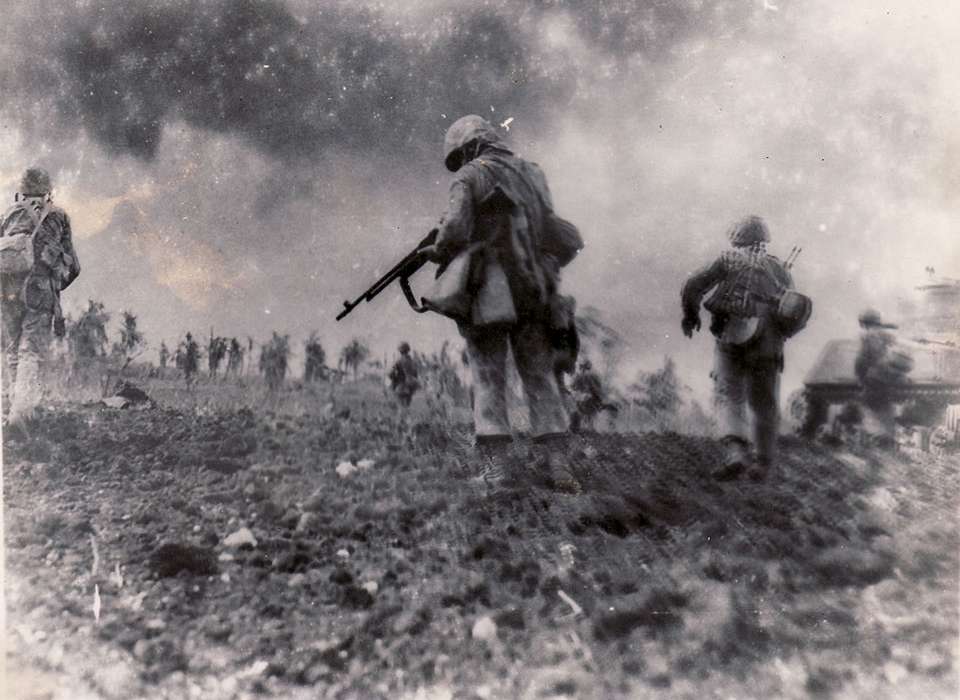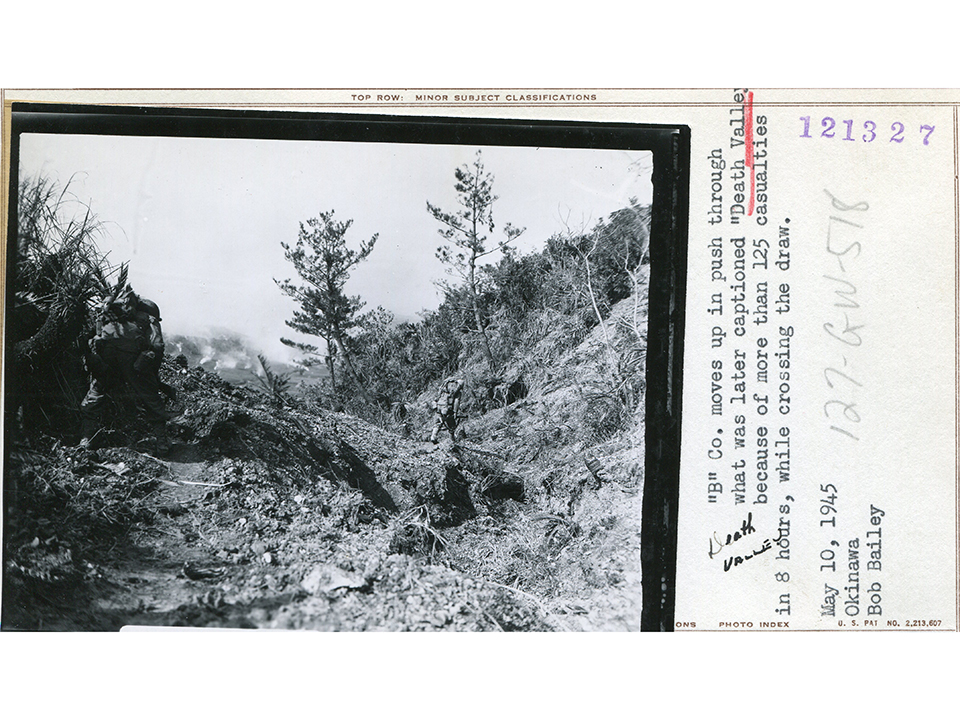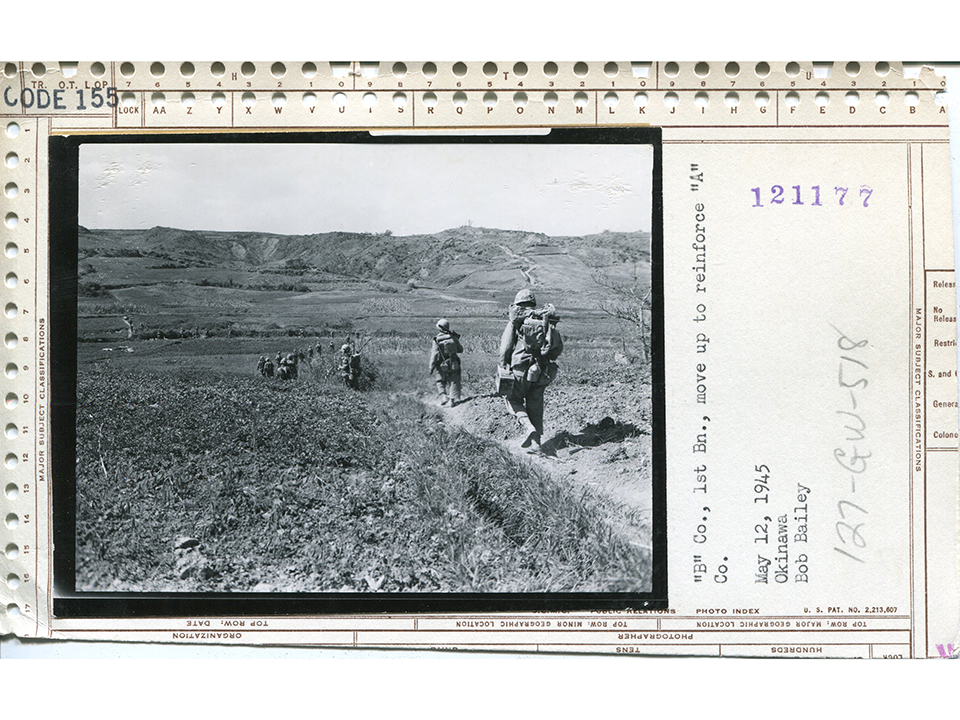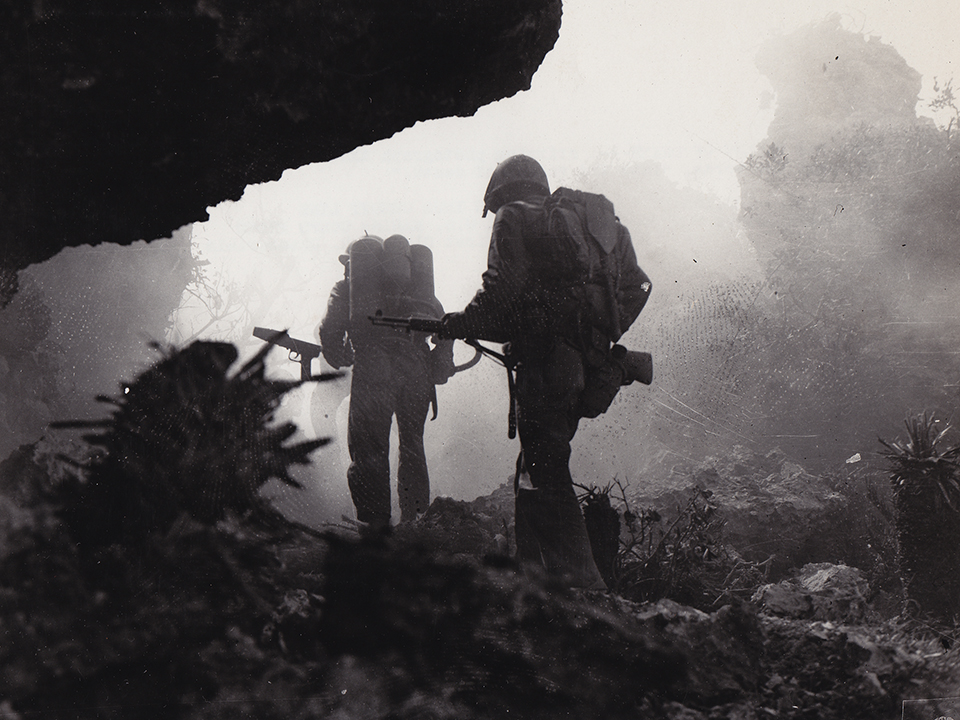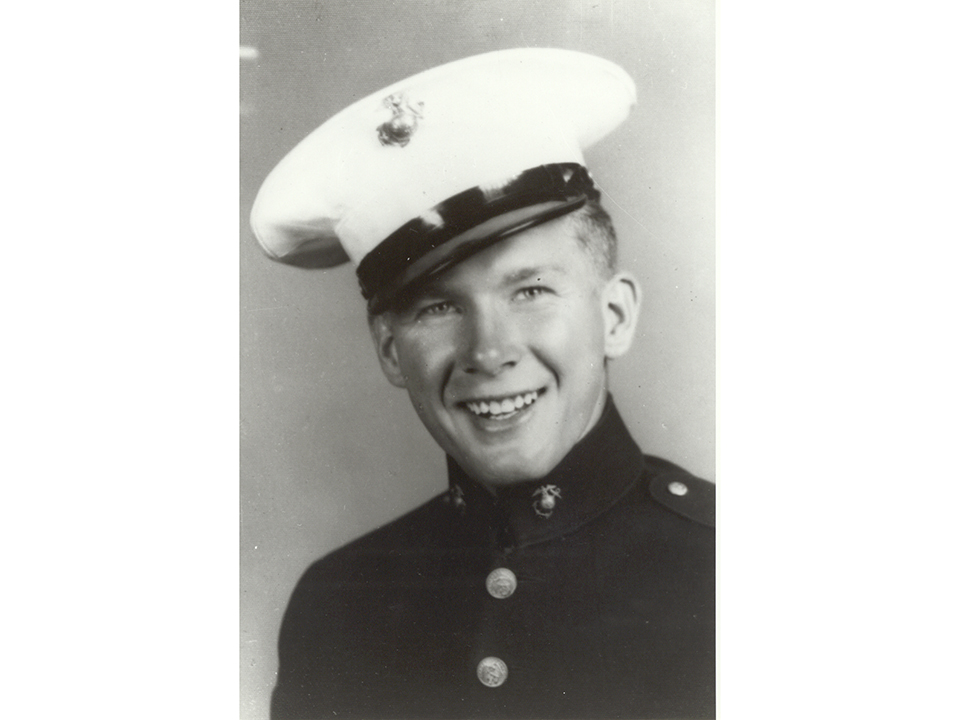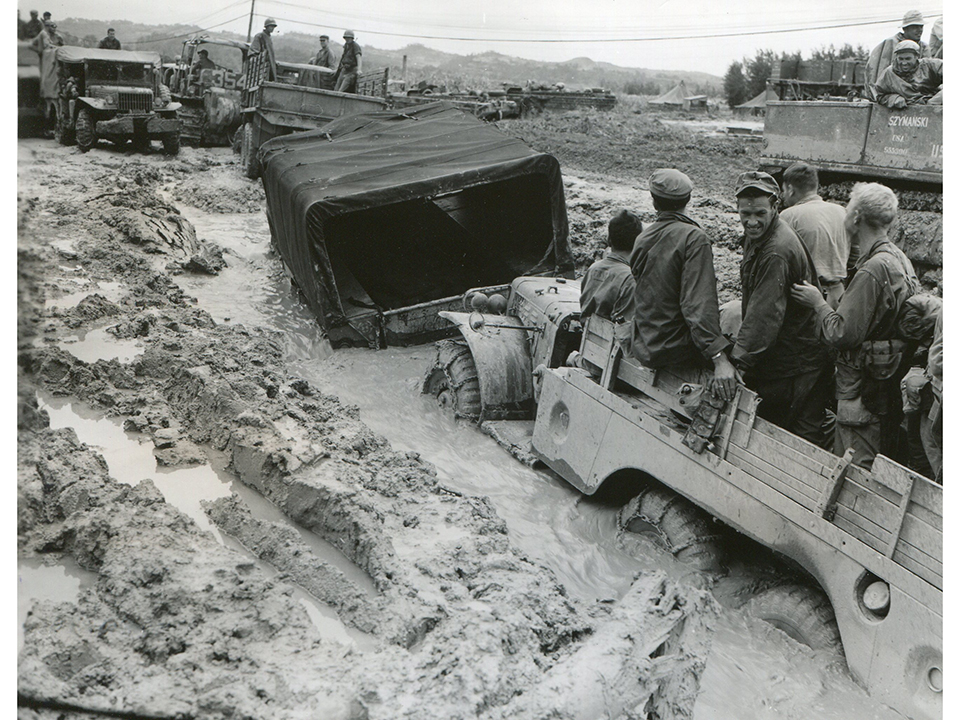Following the Army’s bloody meatgrinder fight in front of, around, and finally through the formidable Japanese defensive line at Kakazu Ridge in April, the Tenth Army’s push south through Okinawa continued, albeit at a snail’s pace. The battered 27th Infantry Division who had worn themselves down numerous times in front of Kakazu were pulled off of the line for a respite and relieved by the veteran 1st Marine Division as the push continued against the Shuri Line.
The division advanced, slowly, across the southern portion of Okinawa. Their advance was made at a glacial pace due to the fanatical Japanese resistance along the Awacha defensive pocket faced by the 1st Marine Division. The “Old Breed” was populated by an equal mix of fresh new faces and combat hardened veterans of Cape Gloucester from the murderous fight at Peleliu where it encountered incredibly intense fighting along Peleliu’s cave-pocked coral terrain. As such, it was the most experienced division at the disposal of the Tenth Army when it came to cave fighting. However, that experience did not pan out when it came to meeting the Japanese who were holed up in the caves that dotted Awacha up and down the line.
Everything about the terrain on Okinawa favored the defending army. The topography of ridge lines and escarpments turned the field of battle into a series of small, vicious firefights that allowed the Japanese full observation of their enemy due to the lack of dense vegetation. Interlocking fields of fire from the caves and concrete Okinawan tombs all over the ridge lines provided for intense and heavy small arms fire, while Japanese artillery could be brought to bear on the attacking Marines in seconds by numerous guns camouflaged into hill and ridge sides, unseen by American eyes.
The veteran warriors of the 5th Marine Regiment moved into the lines on May 1. On the first night of action the 5th Regiment was assailed by Japanese infiltrators in a series of small assaults that broke down into ferocious hand to hand combat each time. In the morning, the Marines had beaten off the attackers. Dead Japanese lay strewn across the battlefield, some with Marine Ka-Bars sticking in their chests, some disemboweled by Marine bayonets, and still others peppered with shrapnel from Marine grenades or holed by rifle and machine gun rounds. As Marines behind the lines ran supplies up to the grunts in the front, one survivor of the night action and a veteran of Peleliu was heard to tell his foxhole buddy about the upcoming fight, “This right here…well…this is gonna be a bitch.” He had no idea how accurate his prophecy would be.
The survivors of the night assault received an unexpected break after the fight. During the early morning hours of May 2, it started to rain. And rain. And rain. The rain poured down in buckets on the 5th Marines, so much so that the unit had difficulty moving at all, and all offensive action ceased. The break allowed the men to catch their breath and prepare for the upcoming assault that began the following day. The Marines emerged from the mud (a scene that would play itself out again and again for the remainder of the campaign) and pushed forward into heavy fire. Despite the enemy fire, the Marines advanced forward with the help of the Army’s 27th Infantry Division field artillery. Nearly a week later, the Marines had reduced the Awacha Pocket and suffered accordingly. Casualties had been high but the 5th Regiment had prevailed and been able to eliminate the fierce pocket of Japanese resistance, only to prepare to move onto the next ridge line ahead.
However, instead of going on the offensive, the Marines found themselves on the defensive after the Japanese launched a counterattack that involved an amphibious landing behind the Marine lines on the night of May 5. Marines of the 1st Marine Regiment and 3rd Armored Amphibious Battalion greeted the would-be invaders at night on the beach with intense fire. The Japanese assault resulted in over 800 dead Japanese in the all-night fight. The following morning, Marines and their war dogs tracked down and killed the remaining 65 invaders. After fending off the Japanese amphibious assault, the entire 1st Marine Division took the initiative and launched a counteroffensive which netted a kill total of over 6,000 enemy troops and well over 50 pieces of artillery.
In a short period of three days, the strength of the Japanese directly in front of the “Old Breed” had been whittled down considerably. Not that the Gyrenes in the front noticed any difference. The depleted enemy gave the Americans a chance to move forward in force.
As the advance began, the 1st Marine Division ran into “another damned ridge."
In front of the “Old Breed” lay Dakeshi Ridge. Dakeshi was small but dangerous, with ridge lines with treacherous valleys and enfilading fields of fire that would prove deadly to the 7th Marine Regiment now moving up to assault the line. Launching their attack on Dakeshi on May 11, the initial assault went well, with Marines from the 7th Regiment reaching the crest of the ridge by mid-day, only to be forced to withdraw due to heavy enemy counter fire. The following day, the 7th Regiment again assaulted Dakeshi, took the ridge line and proceeded to hold it against a series of Japanese counterattacks from the reverse slope of the ridge that lasted all day and into the following morning. Beyond Dakeshi lay the next series of objectives for the “Old Breed." Wana Ridge, and Wana Draw were the next two targets, laying some 1200 yards away from the newly captured and defended Dakeshi. It was expected that 1200 yards of ground could be crossed and taken in a day at most. It would take the 1st Marine Division 18 days to cross and hold those 1200 yards of Okinawan earth.
In those 18 days, all three infantry regiments of the 1st Marine Division would hurl themselves against Wana Ridge and Wana Draw. The ridge fell relatively quickly, in 3 days. Wana Draw, however, was a different story. With towering valley walls and cliffs guarding each side of a meandering valley floor, covered with heavily defended caves and pillboxes, Wana Draw was referred to Death Valley by those lucky enough to survive it. The 7th Marines, who had lost some 700 men in the actions against Dakeshi only days before, lost another 500 in the following five days at the opening stages of the assault to take on Wana Draw.
The Japanese were holed up in caves that were incredibly difficult to reach. The caves that could be approached, which were few, were often sealed shut with explosives after the attacking Marines suffered severe casualties. However, the majority of the caves in the Wana complex were inaccessible except to the Japanese, and that was by tunnel at night. Improvising as they usually did when fighting entrenched Japanese, the men of the 1st Marines tried a different method to dislodge their stubborn enemy. Being on the reverse slopes of the ridge line and draw, the Japanese seemed impervious to fire from Marine weapons, but were not impervious to fuel. Grunts from the 1st Marines manhandled barrels of napalm to the top of the ridge line and draw, bashed the tops open with rifle butts and axes, and rolled the open containers down the draw. The barrels inevitably found their way into or near a Japanese cave, and when they did, they were ignited by the Marines above with white phosphorous grenades. Still, despite the new demolition methods, the Japanese held their positions, giving ground literally an inch at a time while inflicting terrible casualties on the “Old Breed." From May 11-30 in the fight in and around Wana Ridge and Wana Draw, the 1st Marine Division would lose some 200 Marines for every 100 yards of enemy territory captured.
While death was a constant companion to anyone wearing Marine dungarees daring to venture into or even near Wana Draw, so was valor. Louis Hauge was a machine gunner in C Company 1st Battalion 1st Marine Regiment and a veteran of the Peleliu campaign. On the afternoon of May 14, Hauge led his machine gun squad near the base of one of Wana’s seemingly endless supply of small hills, knolls and ridge lines. Hauge’s company, much like the rest of the 1st Marines, slowed their assault due to enemy fire and dug into what precious little ground they held. As night fell, the left flank of Hauge’s line came under intense mortar and machine gun attacks that poured enfilading fire into his fellow Marines from several positions to Hauge’s left front. With members of his platoon being hit and killed all around him, Hauge raised his head to see if he could spot where the shooting was coming from. Being on the far right of the line and not under direct fire, Hauge spotted the two enemy positions raining fire on his platoon. Hauge ordered his machine gun squad to hold their positions and cover him.
Stuffing grenades in every pocket he had and hanging more from his belt, Hauge grabbed his rifle, jumped out of cover and ran headlong at the closest enemy machine gun position. The Japanese immediately saw him as he ran towards the position and shifted fire to the onrushing Marine from Minnesota. As he neared the first Japanese machine gun position Hauge was struck by at least three rounds from one of the enemy weapons. Unfazed by his wounds, Hauge began furiously hurling grenades at the closest position. The grenades killed the Japanese occupants and destroyed the machine gun. Upon seeing the position knocked out, the remaining Japanese machine gun pinning down Hauge’s company poured fire at him, hitting Hauge several more times. Still the Marine charged on. As he neared the last enemy position, Hauge threw his remaining grenades and emptied his rifle on the crew, killing them all. Hauge turned around to call his squad forward and as he did, he was struck by several rounds of Japanese rifle fire, killing the fearless young Marine. His squad and his platoon, seeing this one man charge and being inspired by his bravery, stood up and charged the Japanese positions, eliminating them and capturing the small hill. For his fearless action in eliminating the enemy positions and his incredible display of bravery, Hauge was posthumously awarded the Medal of Honor.
While the Marines and soldiers had dealt with the Japanese in spades, the one thing they hadn’t had to deal with, at least until May 21, was the weather. The weather on Okinawa until that point had been quite good. There had been periods of heavy rain but overall, the weather had been nearly perfect. That all vanished in the early morning hours of May 21. That morning, the heavens opened on the Americans on Okinawa. The rain came in sheets and simply did not stop. The monsoon season had arrived and with it came torrential rains and rivers of putrid Okinawan mud. For the 1st Marine Division mired in Wana Draw, the terrain, already covered with the dead and rotting corpses of Japanese infantry, became a cesspool of disease and death. Wana Draw, essentially, became Wana Lake. The rain was so heavy that the draw, at points, filled up with water over twelve feet deep. Infantry units in positions in and around the Draw found themselves cut off by water. Tanks were useless, LVTs (amphibious tractors used in beach assaults) became mired in the mud, leaving the infantrymen to retrieve their own supplies and carry out their own wounded by hand through rivers of mud that were often knee deep.
While being shot at by Japanese infantry and bombarded by Japanese artillery was deadly and terrifying, the mud soon became the grunt’s worst enemy. It infested everything. Everything. The mud found its way into boots, underwear, hair, ears, noses, food, sealed cigarette packets, weapons, wounds…everything one can name. Generally, a Marine could take about three to four steps before his boondockers, already caked in inches of mud, were literally sucked off of his feet. The constant mud soon gave way to trench foot which immobilized the miserable Marines and irritated everything, from feet to nerves and stamina. Living conditions, already poor in a combat zone anyway, became downright atrocious. The dead bloated corpses of the enemy soon were covered in swarms of flies. After a few days, the bodies of the enemy soldiers disappeared under a river of mud. Those same bodies would be “discovered” when Marines would take ground formerly occupied by those corpses and dig in. Many battle-hardened Marines would suddenly begin to wretch or cuss in blue streaks when their entrenching tools would strike a hard surface beneath the mud, only to discover that hard surface was the rotting maggot-infested corpse of the enemy, now occupying the mud-filled foxhole the Marine had just dug to protect himself from incoming Japanese mortar rounds.
The constant rain offered the Marines little chance for sleep, little food, and no dry clothes at all. The Marines on the line were often hungry, always exhausted, and constantly wet. It began to wear on even the most hardened veteran’s nerves. Psychological casualties during this period of the campaign rose at an alarming rate. Men, replacements and veterans, were pulled off the line all too often.
Offensive actions on the line, for all intents and purposes, ceased. So-called “aggressive patrolling” became the order of the day as the “Old Breed” finally captured Wana and the surrounding territory near the end of May, knee deep in the incessant Okinawan mud. With Shuri Castle in front of the battered remnants of the 1st Marine Division, the “Old Breed” caught its breath, although only for a short while. The campaign was not over yet.
As trying as the campaign had been so far for the 1st Marine Division, they were not the only Marines on Okinawa. Their brothers in the 6th Marine Division on their flank had suffered, too. Horribly. Their campaign on Okinawa reached its bloody high point at the same time the 1st Marine Division ran into Dakeshi and Wana. The 6th Marine Division’s meat-grinder would come at a small little hill, unobtrusive on any military map, but unforgettable to any survivor. A little hill named “Sugar Loaf."
This article is part of an ongoing series commemorating the 75th anniversary of the end of World War II made possible by Bank of America.
Seth Paridon
Seth Paridon was a staff historian at The National WWII Museum from 2005 to 2020. He began his career conducting oral histories and research for HBO’s miniseries The Pacific and holds the distinction of being the first historian hired by the Museum’s Research Department. In the 12 years he was Manager of Research Services, Seth and his team increased the oral history collection from 25 to nearly 5,000 oral histories.
Cite this article:
MLA Citation:
APA Citation:
Chicago Style Citation:
